China # 14 – Xi’an’s Terracotta Warrior Army – September 2014
The Terracotta Warrior Army in the ancient city of Xi’an, China is sometimes called the Eighth Wonder of the World. We have all heard about it, maybe have seen pictures or read about it, but in fact, standing in front of it is totally astounding and amazing and nearly beyond imagination. We were looking down at what was an underground mausoleum with as many as 8,000 individual soldiers, horses, chariots, musicians, dancers, acrobats, and anyone who might have been of service or comfort to Emperor Qin Shi Huang in his life after death. Why?
Qin Shi Huang, First Emperor of China
(259 BC to 210 BC)
3,000 years ago the Chinese commonly believed that there was life after death (Buddhists believe in reincarnation). Hey, maybe there is, since no one has died and come back to tell us about it. It could be a comforting feeling. Often wives, soldiers and personal servants were buried with a ruler or other important dignitaries to serve him or her in life after death. They were either killed or committed suicide. While it was considered an honor to be buried with the deceased, there was growing objection to the brutal loss of human life. Understandably, some people particularly didn’t want to be buried with their dead ruler. Slowly the custom changed to bury the dead with small clay figurines and later, a larger life-size replica as a substitute for the living. Emperor Qin Shi Huang took the custom a step further.
Life after Death
With his life after death in mind, Emperor Qin Shi Huang ordered the creation of his mausoleum and the surrounding areas that included the Terracotta Warrior Army to serve him.
The project took 36 years and consumed the conscripted labor of over 700,000 men and women.
Qin Shi Huang lived from 259 BC to 210 BC. At thirteen, he became King of Qin and later, at age 38, China’s first Emperor after conquering the Warring States to unify all of China. He was the founder of the Qin Dynasty. During his reign, he also started a weights and numbering system, a monetary system, built roads and ordered the first stage of The Great Wall to be constructed.
Now you have to imagine that his “army” was buried completely out of sight. Three deep pits, some over 62 m, (200 ft.) long, were excavated to a depth of 5 m, (16 ft.). The floors of these pits were made of compacted earth and paved with bricks. The Terracotta Warriors and other figures were placed in perfect order on these paved hallways. All were facing east toward the China that the Emperor had created.
The Terracotta Warrior Army
Thick walls separated individual hallways and were designed to hold massive beams that were then covered with heavy fiber woven mats, followed by layers of earth and soil, and planted to totally disguise that there was ever anything beneath them. As soon as the Terracotta Assembly was finished, compete with horses, chariots and attending servants, the sloped roads leading into the pits were closed and sealed forever. While there are records about the mausoleum and its construction, no records have been found about the Warrior Army. It was not until 1974 when farmers digging a well discovered the first well-preserved terra-cotta head and called authorities.
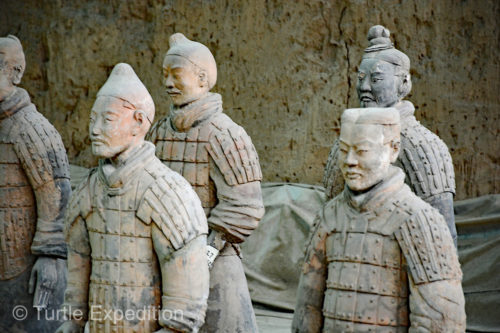
Did the artists model these soldiers from real people or was it their artistic ability to create so many different looking statues?
It is difficult to even imagine the work that has gone on to unearth and reconstruct these amazing figures, often from just broken pieces. Some of the brilliant colors including reds and greens, blues and pinks remained quite visible. Each warrior weighed about 600 to 650 lbs. and stood over 6 ft tall. Face cognition experts have determined that no two faces are identical. Some were armed with bronze weapons including spears, axes, daggers and curved knives. Others held crossbows and quivers of arrows. All weapons were deadly sharp, a demonstration of an advanced level of metallurgy.
The following images of what we saw can in no way encompass the immensity of this discovery. According to China Daily, over 500 million visitors traveled to the ancient capital city of Xi’an over the past five years. This leads us to make a point: If you want to see the Terracotta Army, fly there and take a tour—-don’t drive there! As an option, check out Secrets of the Dead – China’s Terracotta Warriors on YouTube.
- Protected from the elements, the main pit has been covered inside a huge temperature controlled hanger.
- Lined up in perfect order and ready for battle.
- An estimate of 8000 soldiers are lined up in military formation.
- Archeologists can tell from the position of the warriors’ arms and hands what weapons they carried, spears, axes, daggers, curved knives or crossbows and quivers of arrows.
- Heads may have been removed for restoration.
- Like good warriors, they wait to be placed in their rank and file. Each man weighed 600 to 650 pounds and stood about 6 ft tall.
- Horses were an important element of the army.
- Forensic face recognition technology has shown that no two warriors are the same. Was this done by a whim of the sculptor or did the men model for the image?
- The restoration process will take years to complete.
- Archeologists sift through the broken rubble looking for a small piece of history. It may be the world’s greatest puzzle.
- The entire terracotta army has been buried under 2,000 years of mud and earth. Restoration is slow.



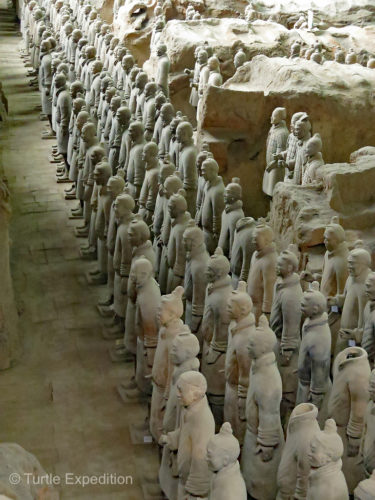
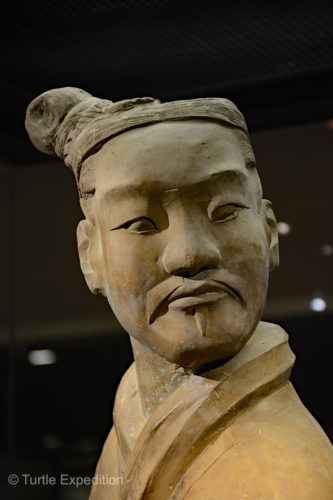
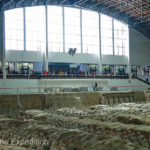
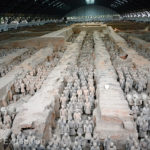
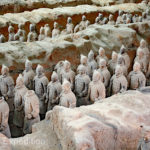
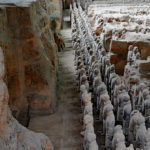
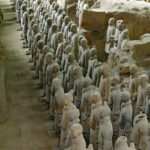
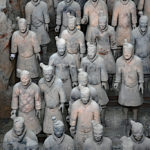
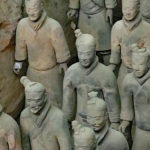
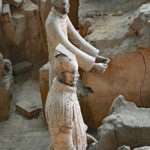
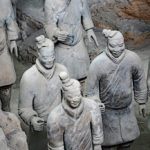
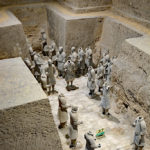
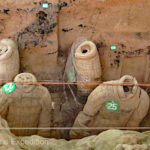
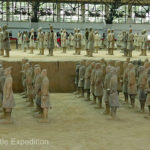
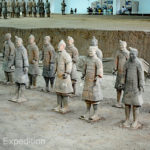
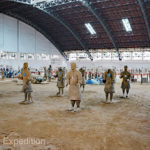
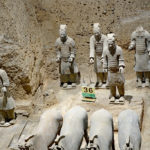
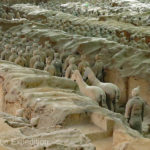
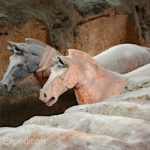
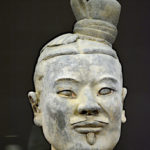
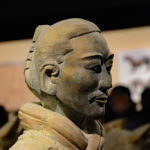
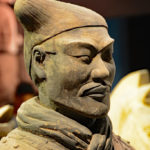
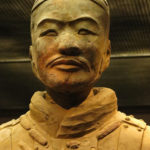
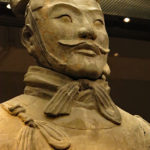
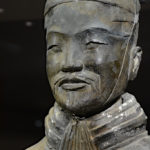
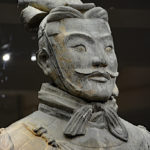
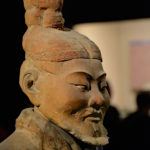
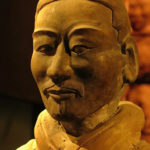
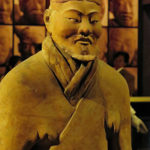
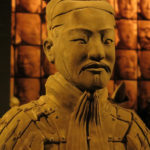
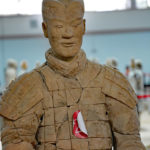
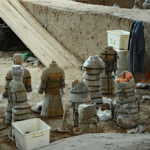
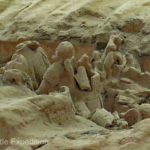
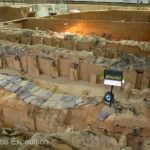
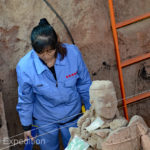
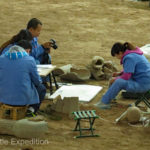
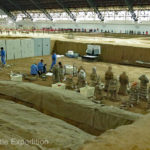
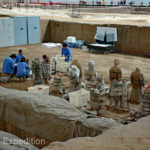
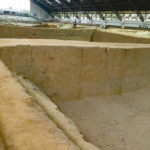
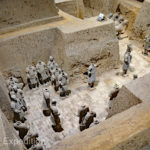
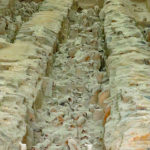
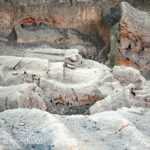
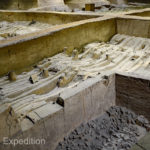
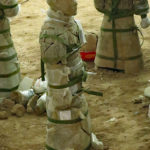





Leave a Comment